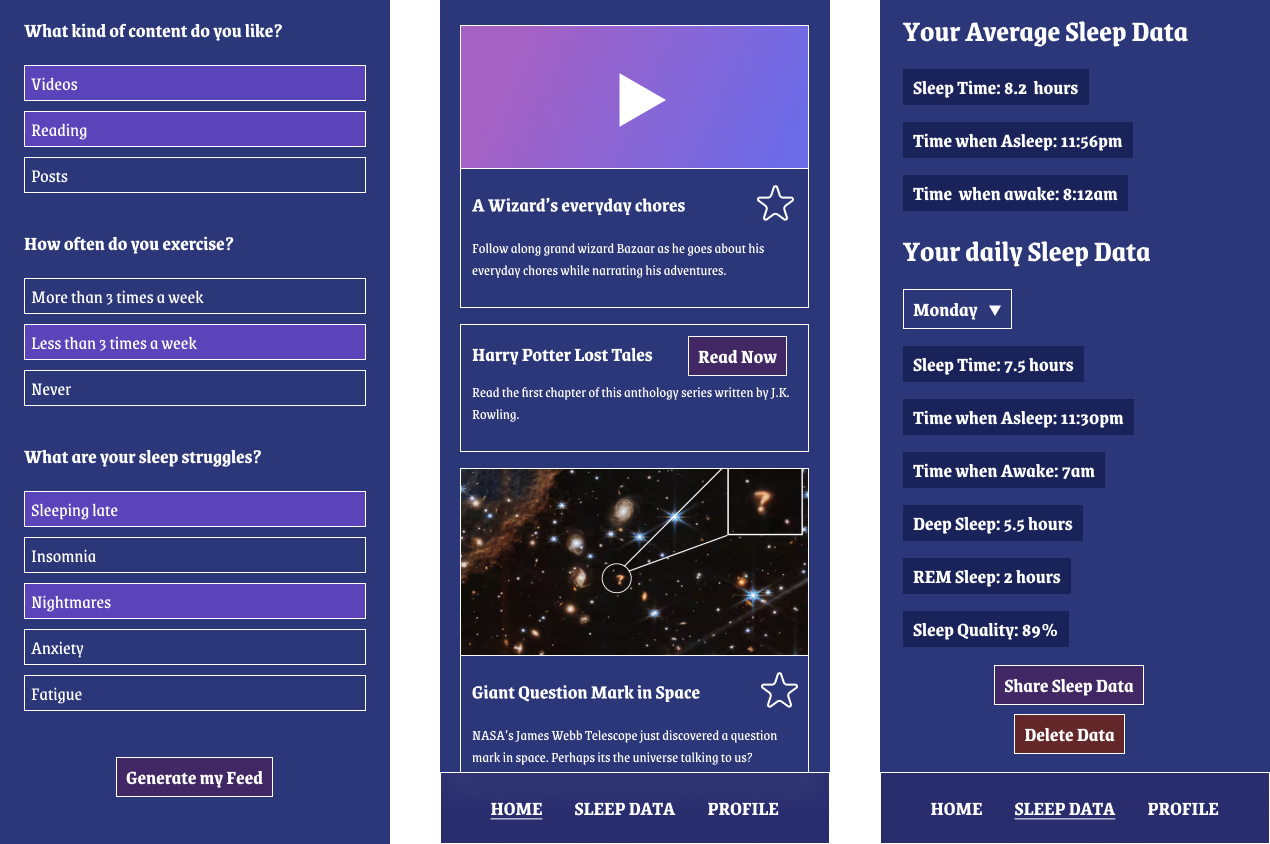Yongtae Park Remmy Sharma Diane Szonyi Nadine Temesfoi
UI/UX Visual design Research
UX Design

I participated in a UX Design competition called CreateSC hosted by the Roski School of Art and Design with a group of talented individuals. We made it to the finals and placed 7th out of 168 submissions.
PROBLEM
Users have a reduced quality of sleep at night after using social media platforms right before bed.
DEFINING PAIN POINTS
• Users discussed how hard it is for them to not use social media before bed and described scrolling through their social media feeds as an unending experience.
• Users complained that they had to download multiple apps like Calm, Sleep Sensor, etc. to track their sleep data and help them fall asleep. It was hard to find a solution that would combine sleep data tracking and aid in users' attempts to get better sleep.
• Users wanted the current solution space to expand outside of just stories and meditation content.
Write something here about how we solved the pain points above.
OUR APPROACH
BLHA BLAH

RESEARCH
When we started the project, we came up with research questions that would guide our design process. We interviewed students, teachers and parents near the USC locality. Here are some questions we were interested in asking and the important insights we found.
• How do you feel about science concepts taught in class? (For Students)
• What kind of educational application do teachers like to use? (For Teachers)
• How can we generate your child's interest in our app? (For Parents)
RESEARCH INSIGHTS
After conducting user interviews, we found that a lot of students struggled with STEM content as they found it boring and monotonous. Even though students enjoyed science shows and movies, they felt that education was separate from entertainment and found it boring. A lot of students commented they would rather play games than study science. Our interviews with teachers revealed that they wanted an application that would help them understand their class performance along with engaging interest in the topics they teach. Parents talked about using trendy designs and symbols to generate their children's interest in otherwise boring content.

COMPETITIVE ANALYSIS
To understand the problem space we were exploring, we investigated companies like TerraGenesis, Galactic Genius, and Brain Pop. An important competitor was Terra Genesis as they were educating students about scientific concepts by challenging them to successfully terraform different planets. Users are part of different factions as they race to terraform multiple planets. This application used gaming techniques to pique student's interest in STEM concepts.

PERSONAS
We created user personas to help shape our product strategy and accompany us during future usability testing sessions. From the insights generated via research, we were able to develop three user personas to reflect our different potential users.

AFFINITY MAPPING
Using all the important concepts we gathered from our research insights and competitive analysis, we decided to conduct affinity mapping to further categorize our ideas and create connections between features and common themes. Game theme was a central insight generated from our research. We were interested in exploring how applications like Busuu or Lumosity used gaming techniques to help users learn and memorize content.

After conducting research, we wanted to spend time ideating our design by first sketching (Crazy 8s) and then proceeding to wireframes. Our priority through our design was getting feedback for each stage of prototyping. We wanted to create a fun gaming environment for kids along with a strong channel of communication between students and teachers.
LOW-FI WIREFRAMING
Our wireframes were focused on motivating students to perform well and giving them points to update their avatars. For educators, we wanted to create an overview of student performance where teachers could also track score history for individual students. We created a map section so students could access missions from location pointers in order to imbue an adventure theme for the student experience.

USER FEEDBACK
During our first user testing session we learned that a lot of student users had trouble with the map section to access games and they found the contrast was too low. We also found that students were disinterested in the avatar system and were more interested in machines. An educator suggested shifting focus to machines and upgrading them for hints through missions. Teachers believed the dashboard was confusing and wished to see an inforgraphic showing class performance over time along with assigned missions. Students asked to expand chat not only to teachers but to other classmates as well.

FINAL PROTOTYPE DESIGN FOR STUDENTS
After collecting feedback and organizing our insights, we were able to create the next prototype with a more clear understanding of students' needs and priorities.
STAKEHOLDER FEEDBACK
Stakeholders gave generally positive feedback during our presentation. Educators really appreciated how versatile the community page was and liked that students could share mission results with other classmates and teachers. A NASA representative really liked the machines page and how we were incorporating different rovers in the missions. A general area of improvement indicated by critique was the quiz section where stakeholders indicated design could be improved.

Through this process, I was able to form invaluable bonds with my team members and learn from their diverse skill sets. During our process evaluation, we realized that there were some areas where we experienced setbacks. We should have designated more time for designing wireframes and conducting open card sorting during the research phase. Overall, this process was really enjoyable as we were able to spend time with NASA educators to learn about their vision and learn to incorporate the same with educator and student needs. The journey was challenging but we thoroughly enjoyed it.